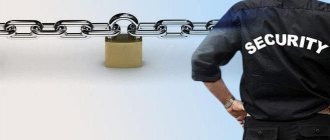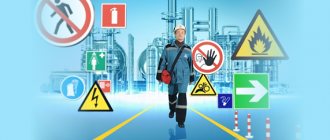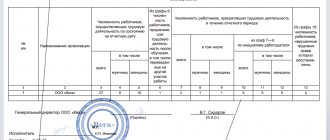What is “safety precautions”
The definition of “safety precautions” means a set of certain rules, drawn up in the form of a single document, which employees of the enterprise are required to comply with when performing their work functions. These rules are usually developed at the very beginning of the organization’s creation and are based on individual legal norms and the specifics of the company’s work.
Safety precautions reflect the measures that must be taken when working with certain devices and equipment, information about personal protective equipment, and procedures for dealing with life-threatening or health-threatening situations.
Not all company employees are required to undergo this type of training, but only those who have direct access to production lines or some equipment. But, for example, such briefings are usually not carried out for office workers.
Most often, safety training is in demand at enterprises with hazardous and harmful working conditions (chemical, biological, physical or radiation).
GIT checklists (full list)
The first way to prepare for an imminent visit by a labor inspector is to download the State Labor Inspectorate checklists that are specific to your enterprise and begin a self-test.
Because occupational safety checklists contain a complete list of questions that will be of interest to the inspector, a list of documents and materials that must be developed and implemented at the enterprise, for submission to the state labor inspectorate for review.
For each GIT checklist, I left a link to the document in Google Drive, by clicking on the number of each, you can familiarize yourself with it, if necessary, download, print or add the document at the same time to your Google Drive.
It’s very convenient for me to use it this way, but if anything is unclear to you, please contact me in the comments.
List of GIT checklists approved by Rostrud order No. 655 and edited by order No. 201 dated 04/11/2018:
- all PL in one folder;
- CL No. 1 “Checking the correctness of employment”;
- ChL No. 2 “Control of the content of employment contracts”;
- ChL No. 3 “Checking the correctness of making adjustments to employment contracts”;
- ChL No. 4 “Checking the termination of employment contracts”;
- ChL No. 5 “Control over the established operating hours and recording of working hours”;
- ChL No. 6 “Checking the correctness of the provision of annual paid leave”;
- ChL No. 7 “Supervision over the calculation and payment of wages”;
- ChL No. 8 “Control over the implementation of labor of minors”;
- ChL No. 9 “Control over the implementation of labor of foreign workers”;
- ChL No. 10 “Control over the implementation of labor of disabled people”;
- ChL No. 11 “Control over the labor of women and persons with family responsibilities”;
- ChL No. 12 “Control over the implementation of labor of persons working in the Far North and in areas equivalent to it”;
- ChL No. 13 “Supervision over working hours”;
- ChL No. 14 “Control of the correctness of dismissals of employees during layoffs”;
- ChL No. 15 “Control over the provision of annual additional vacation";
- ChL No. 16 “Control over the provision of other rest (not taking into account annual paid leave)”;
- ChL No. 17 “Supervision over deductions from wages”;
- ChL No. 18 “Supervision over the organization of underground work, as well as hazardous working conditions”;
- ChL No. 19 “Control over involvement in work beyond working hours”;
- ChL No. 20 “Control over the organization of investigations and recording of NS, occupational diseases”;
- ChL No. 21 “Supervision of the implementation of special assessment and assessment”;
- ChL No. 22 “Control of notification of employees about conditions and occupational safety in the Republic of Moldova, about the risks of harm to health, provision of guarantees, compensation and personal protective equipment”;
- ChL No. 23 “OT control at altitude”;
- ChL No. 24 “Control of safety during operation of electrical installations”;
- ChL No. 25 “Work safety control for construction work”;
- ChL No. 26 “Control of occupational safety in agriculture”;
- ChL No. 27 “Supervision of preliminary and periodic medical examinations”;
- ChL No. 28 “Supervision of OT training”;
- ChL No. 29 “Work safety control for loading and unloading operations”;
- ChL No. 30 “Supervision over the acquisition, issuance and use of certified and declared PPE and VKZ”;
- ChL No. 31 “Supervision over the creation and operation of an OSMS”;
- ChL No. 32 “Supervision of ensuring the work and rest regime of employees”;
- ChL No. 33 “Supervision over the provision of sanitary services and medical services. provision of employees”;
- ChL No. 34 “Control of the development and approval of rules and instructions on occupational safety for employees (clause no longer in force) ”;
- ChL No. 35 “Control over the availability of a set of legal regulations that have labor safety requirements for the organization’s profile of activity”;
- ChL No. 36 “Monitoring the implementation of occupational safety and working conditions in the Republic of Moldova”;
- ChL No. 37 “Monitoring the timely familiarization of employees with occupational safety requirements”;
- ChL No. 38 “Control of labor safety in housing and communal services”;
- ChL No. 39 “Control of labor safety for electric welding work”;
- ChL No. 40 “Control of labor safety for gas welding work”;
- ChL No. 41 “Control of occupational safety during the operation of thermal power plants”;
- ChL No. 42 “Occupational safety control during the operation of refrigeration units”;
- ChL No. 43 “Control of occupational safety for work in confined or confined spaces”;
- ChL No. 44 “Control of fire safety in vessels operating under pressure”;
- ChL No. 45 “Control of occupational safety for gas-hazardous work”;
- ChL No. 46 “Control of occupational safety for hot work”;
- ChL No. 47 “Control of occupational safety for painting works”;
- ChL No. 48 “Control of safety regulations for underwater blasting”;
- ChL No. 49 “Control of occupational safety for repair work of buildings and structures”;
- ChL No. 50 “Health safety control during the operation of water supply and sanitation networks”;
- ChL No. 51 “Control of occupational pollution with pesticides (pesticides) and mineral fertilizers”;
- ChL No. 52 “Control of occupational safety in chemicals.” laboratories”;
- ChL No. 53 “Installation control, technical. maintenance and repair of technological equipment”;
- ChL No. 54 “Control of labor safety for repair work and maintenance of lifting machines”;
- ChL No. 55 “Occupational safety control during painting activities”;
- ChL No. 56 “Occupational safety control during the operation of boiler houses”;
- ChL No. 57 “Occupational safety control during the operation of gas facilities”;
- ChL No. 58 “Health safety control during the operation of fuel oil facilities”;
- ChL No. 59 “Health safety control during the operation of solid fuel warehouses”;
- ChL No. 60 “Occupational safety control during activities related to technological transport”;
- ChL No. 61 “Occupational safety control during activities related to tools and devices”;
- ChL No. 62 “Control of occupational safety for logging, forestry work and woodworking”;
- ChL No. 63 “Control of occupational safety in sea and river ports”;
- ChL No. 64 “Control of earthworks”;
- ChL No. 65 “Work safety control during the operation of conveyors”;
- ChL No. 66 “OT Control for charging and maintenance of batteries”;
- ChL No. 67 “Warehouse safety control”;
- ChL No. 68 “OT control for draining and loading of petroleum products”;
- ChL No. 69 “OT control for maintenance, repair and inspection of the condition of vehicles”;
- ChL No. 70 “Control of labor protection for the transportation of goods and passengers using vehicles”;
- ChL No. 71 “Health safety control during the operation of trucks”;
- ChL No. 72 “Occupational safety control during the operation of in-plant transport”;
- ChL No. 73 “Work safety control during installation work”;
- ChL No. 74 “Work safety control in the manufacture and assembly of metal structures”;
- ChL No. 75 “Occupational safety control during cold processing of metals”;
- ChL No. 76 “Occupational safety control during the use and maintenance of machine-building production equipment”;
- ChL No. 77 “Occupational safety control in foundry production”;
- ChL No. 78 “Work safety control in mechanical engineering”;
- ChL No. 79 “Health safety control during the repair of bridges and overpasses”;
- ChL No. 80 “Occupational safety control during maintenance and repair of intra-port transport”;
- ChL No. 81 “Health safety control during the operation of machines and mechanisms in the port territory”;
- ChL No. 82 “Occupational safety control during the operation of lifting machines and mechanisms”;
- ChL No. 83 “Control of plumbing and plumbing work”;
- ChL No. 84 “Work safety control for dry cleaning and washing”;
- ChL No. 85 “Work safety control when using a bulldozer”;
- ChL No. 86 “Control of labor safety when using an excavator”;
- ChL No. 87 “OT Control when using a tractor”;
- ChL No. 88 “Health safety control during road repairs”;
- ChL No. 89 “Control of OT when using the skating rink”;
- ChL No. 90 “Work safety control when laying asphalt concrete”;
- ChL No. 91 “Control of traffic safety during road markings”;
- ChL No. 92 “Work safety control in a printing organization”;
- ChL No. 93 “OT Control in soldering, tinning, surfacing”;
- ChL No. 94 “Work safety control on metalworking machines and equipment”;
- ChL No. 95 “Health safety control during the use, transportation and storage of liquefied gas cylinders and gas cylinders”;
- ChL No. 96 “Work safety control in cement production”;
- ChL No. 97 “Health safety control during milk processing”;
- ChL No. 98 “Work safety control during the production of bakery and pasta products”;
- ChL No. 99 “Health and safety control during the production of alcoholic and non-alcoholic products”;
- ChL No. 100 “Supervision over the provision of measures during the prevention of emergency situations, preserving the life and health of workers in the event of such situations, including when providing first aid to victims”;
- ChL No. 101 “Other safety control during gas-flame processing of metals”;
- ChL No. 102 “OT Control during spraying and application of metal coatings”;
- ChL No. 103 “OT Control during Heat Treatment of Metals”;
- ChL No. 104 “Occupational safety control during repair and maintenance of agricultural machinery”;
- ChL No. 105 “Control of trade warehouses, bases and refrigerators”;
- ChL No. 106 “Control of occupational safety in urban electric transport”;
- ChL No. 107 “Supervision over the provision of guarantees to health workers”;
- ChL No. 108 “Supervision over the registration of financial liability”;
- ChL No. 109 “Supervision over the provision of guarantees for workers employed by individuals - individual entrepreneurs”;
- ChL No. 110 “Control from the coal industry”;
- ChL No. 111 “Supervision over the provision of guarantees to creative workers”;
- ChL No. 112 “Supervision over the provision of guarantees to athletes and coaches”;
- ChL No. 113 “Control of OT of vocational education and additional enterprises. vocational education, advanced training of workers, conclusion of student contracts”;
- ChL No. 114 “Supervision over the correctness of the implementation of special assessments by organizations conducting a special assessment of working conditions”;
- ChL No. 115 “Work safety control during the extraction of sand and gravel materials on floating mining equipment”;
- ChL No. 116 “Health safety control during storage, transportation and sale of petroleum products”;
- ChL No. 117 “Control of labor safety during the operation of gas stations”;
- ChL No. 118 “OT Control at linear structures of cable transmission lines”;
- ChL No. 119 “OT Control on radio relay communication lines”;
- ChL No. 120 “Control of public catering”;
- ChL No. 121 “Control from the oil and fat industry”;
- ChL No. 122 “Health safety control at meat industry enterprises”;
- ChL No. 123 “Occupational safety control in the production of sugar, molasses and confectionery products”;
- ChL No. 124 “Health safety control during the production of fruit and vegetable products”;
- ChL No. 125 “Control of OT during the release of juices”;
- ChL No. 126 “HSE control for plastics processing industries”;
- ChL No. 127 “Occupational safety control in tobacco production”;
- ChL No. 128 “Control of occupational safety in asbestos-producing organizations, materials and products containing them”;
- ChL No. 129 “Control of occupational safety in the extraction (catch), processing of aquatic biological resources and the release of certain types of products from aquatic biological resources”;
- ChL No. 130 “Work safety control for light industry”;
- ChL No. 131 “Work safety control during finishing work”;
- ChL No. 132 “Occupational safety control during roofing work”;
- ChL No. 133 “Control of security (protection) of objects and (or) property.”
General information about training
The first safety briefing is carried out in conjunction with other types of briefings directly upon hiring. At its core, it is theoretical and practical training in the fundamentals that help personnel maintain safe conditions when performing work functions. Without a mark on its completion, an employee cannot be allowed to perform work. At the same time, instruction is not a one-time thing; over time or for objective reasons (for example, when changing equipment or introducing new technologies), it can be repeated several times.
The briefing can be carried out individually or in a group; all employees who have completed it must attest to this fact in the safety briefing log.
The duration of the briefing is determined on a case-by-case basis.
Failure to comply with safety rules by an employee gives the organization's management the right to apply one of the forms of disciplinary action to him (a reprimand, a reprimand, or even dismissal - in particularly difficult cases). In addition, if the employer suffered material damage as a result of the violation, he also has the right to recover compensation from the subordinate.
Which checklist was canceled
Carrying out inspection activities in private or state-owned structures is regulated by regulations and other legislative documents. It is easy to find out exactly when inspectors will visit the enterprise from the system on the department’s website. To do this, it is recommended to find the documents and answer all the questions specified in it. In this way, you can avoid the negative consequences associated with the arrival of others.
Note! The verification form for the type of development of rules and other standards, including safety instructions, will be canceled in the future. This is planned to be adopted and put into effect, since there is already another check for the event of this plan. The verification will be performed based on the last document.
What is a magazine for, its importance
The importance of the journal is difficult to overestimate. It records the fact that all employees performing their duties in difficult or dangerous production conditions received the necessary training in a timely manner and in full. Thus, it serves as a direct basis for allowing a particular employee to work and, in some way, relieves the organization’s management of responsibility for the occurrence of unforeseen situations.
The absence of a log of safety briefings during inspections by the labor inspectorate or other supervisory authorities can lead to punishment by the company's management, which is usually expressed in the form of a fairly large fine.
What is not included in the SOUT checklist
Rostrud checklists were specially introduced to ensure and strengthen control actions when transferring information on special assessments to the general information system for recording the results obtained. Such a system is called FSIS. It includes all enterprises.
Data transfer is carried out after concluding contractual relations with the management of enterprises. Based on it, it is possible to conduct an expert assessment of the SOUT.
The Ministry of Labor has recently begun to identify which enterprises did not organize a special assessment. The databases will be compared with data from the Federal Tax Service and the Pension Fund. Afterwards, enterprises will be sent warning notices, and then fines will be imposed.
Who is responsible for maintaining the document?
Responsibility for the formation and maintenance of the journal, as a rule, rests with the same employee who conducts these same instructions.
That is, an occupational safety engineer or a specialist in the personnel department (it is these employees who are most often involved in preparing personnel for work). In addition, the responsibility for conducting safety training may be assigned to the head of the structural unit (workshop, site), under whose leadership the person being instructed will work.
What is it about
Rostrud has developed 133 occupational safety checklists for 2020 (approved by Rostrud order No. 655 of November 10, 2017). These forms are used only when conducting scheduled inspections and must comply with the subject of the inspection (paragraph 2, paragraph 8 of Government Decree No. 875 dated 01.09.2012). Inspectors do not have the right to ask questions that are not related to the subject of the inspection and are not included in the checklists of the State Tax Inspectorate for 2020 (paragraph 4, paragraph 8 of Government Resolution No. 875 dated September 1, 2012).
Based on the answers to the questions, inspectors draw conclusions about the employer’s compliance or non-compliance with labor laws.
By topic, the GIT checklists when checking personnel officers are divided into:
- Related to compliance with the general mandatory requirements of labor legislation:
- termination of the employment contract (No. 4);
- compliance with the requirements for the provision of annual basic paid leave (No. 6);
- setting and paying wages (No. 7);
- conducting a special assessment of working conditions (No. 21);
- occupational safety training (No. 28) and others.
- Related to the verification of labor protection requirements. They are divided depending on the type of activity: for example, the occupational safety checklist (2020) contains questions under the following numbers:
- No. 29 - in relation to work at height;
- No. 39 - in relation to electric welding work;
- No. 105 - in relation to work on the operation of commercial warehouses, bases and refrigerators, etc.
IMPORTANT!
On the Rostrud website, in the “Electronic Inspector” section, you can download the GIT checklists for 2021 and independently pass the test on the chosen topic and receive answers to all the questions in the act. The act will allow you to understand whether the organization complies with the requirements of labor legislation, and how your organization is ready for inspection by the inspectorate.
Sample safety briefing log
If you are faced with the need to compile a safety briefing log that you have never encountered before, check out the sample and read the explanations - taking them into account, you will create what you need without much effort.
At first everything is standard. Indicate in the document:
- Name of the organization,
- position and full name of the employee who is responsible for conducting safety briefings and keeping a log,
- the date when the above journal was opened (after the end, also do not forget to put the appropriate mark).
The main section of the document is formed in the form of a table, which is compiled arbitrarily, i.e. the number of rows and columns in it is not limited. But the log must contain the following items: the date of the briefing, position, full name of the employee who completed it, and exactly the same information about the instructor. In addition, both of these people must sign the form. Other information that can also be added to the journal remains entirely at the discretion of the document creator.
Is there a list of answers to Rostrud checklists?
According to established rules, there is an answer to every question posed. For practical reasons, there are no answers to the checklists, since they are specifically developed on the basis of regulations. To make it clear, just look at the OB and OT rules; each paragraph sets out half the answer to the question.
GIT sheets are specially designed to allow independent preparation for the planned visit of inspectors to the enterprise territory. Documents can also be used when creating tickets for employee certification or before hiring outsourcing companies.
What are checklists, how will they help individual entrepreneurs and organizations, what is their purpose?
Previously, GIT inspections were carried out quite chaotically - there was no clear list of questions that inspectors could ask those being inspected. However, with the entry into force of the Decree of the Government of the Russian Federation “On Amendments...” dated 09/08/2017 No. 1080, everything changed. Now, when scheduled inspections are carried out, the State Tax Inspectorate is obliged to use the lists of Rostrud checklists. These are documents approved by Rostrud, which contain questions regarding the application of labor law provisions in organizations, indicating the norms of the law that must be complied with without fail.
Thus, a labor inspection checklist is a list of control questions that inspectors can ask the management of any company or individual entrepreneur. Such questions were introduced for the purpose of Rostrud’s activities to prevent offenses in the field of labor law.
In 2021, not only questions for labor law inspections were approved. Various questionnaires have been adopted - on fire supervision, on supervision in the field of labor legislation, on environmental legislation, etc. However, within the framework of the article we consider exclusively issues of labor legislation.
Checklists for labor activities include issues of compliance with labor legislation, in particular, regarding personnel issues and labor protection.
The introduction of lists is a positive thing. Even before the audit, organizations and individual entrepreneurs will know what questions the inspectors will ask and what specific requirements may be presented. In addition, by studying all the checklists, you can find out which legal regulations could potentially be violated and what you should pay attention to.
Based on the fact that labor legislation contains many disparate requirements that employers are required to comply with, the introduction of lists of questions made it possible to bring them together. Rostrud checklists can be downloaded for free from the link at the end of the article. In addition, they are contained on the Rostrud website.
If the State Tax Inspectorate discovers even one non-compliance with the requirements specified in the mandatory checklists, the organization may be held administratively liable under Art. 5.27, 5.27.1 Code of Administrative Offenses of the Russian Federation.
What areas of work activity are checked using checklists?
Scheduled inspections are not carried out randomly. By virtue of clause 8 of Regulation No. 875, when checking, those sheets that are related to its subject are used. In total, 107 checklists of Rostrud were adopted with a decoding of the requirements and the rules of law that regulate the obligation to comply with such requirements (can be downloaded from the link at the end of the article). However, this does not mean that inspectors have the right to use only one sheet during one inspection. The subject of verification can be formulated quite broadly. For example, if the subject is compliance with labor protection requirements, then sheets 20 to 107 can be used.
Only questions contained in a particular sheet/sheets can be asked. Otherwise, the inspector goes beyond the scope of the inspection, which is unacceptable. However, it should be understood that there are also checklists from the State Labor Inspectorate, which are related to general topics. For example, sheets numbered 1-4 (Appendices No. 1-4 to Order of Rostrud dated November 10, 2017 No. 655) provide for checking the correctness of the conclusion of employment contracts.
Have a question? We'll answer by phone! The call is free!
Moscow: +7 (499) 938-49-02
St. Petersburg: +7 (812) 467-39-58
Free call within Russia, ext. 453
From what date are checklists required during inspections? What are the GIT checklists?
Currently, Rostrud has developed more than 120 checklists for inspections of employers, and this number is planned to increase. Some of them (107 pieces) will soon be approved by departmental order No. 655 dated November 10, 2017. The other part is subject to further refinement.
It was assumed that the above document will come into force from the very beginning of 2021, but for now the order is being registered with the Russian Ministry of Justice. This means that changes may still be made to it.
By the way, therefore, it is not yet objectively possible to implement clause 2 of the Government of the Russian Federation of September 8, 2017 No. 1080. From the beginning of 2021, it was planned to carry out scheduled inspections using checklists in relation to employers assigned a “moderate” risk category. Other employers will be checked with checklists from 07/01/2018. But in any case, checklists cannot be used before the order of Rostrud that approved them comes into force.
Very few checklists are devoted to general labor law institutions. For example, these are the verification sheets:
- legality of deductions from wages;
- the procedure for granting annual leave;
- procedure for registering labor relations;
- procedure for recruiting to work on weekends;
- content of employment contracts, etc.
The rest of the checklists are devoted to labor protection.









